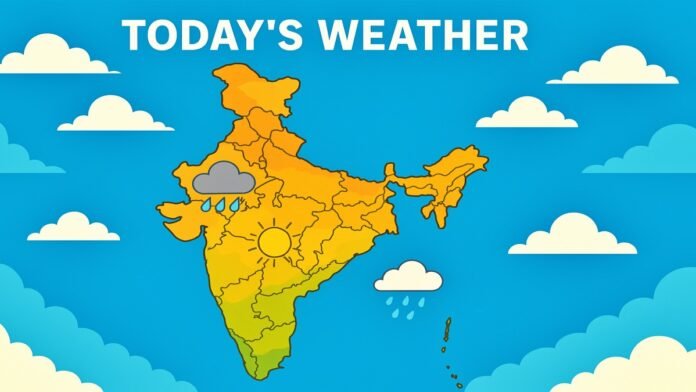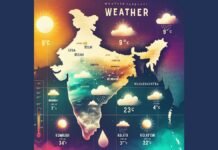
Key Points
- Delhi-NCR and northern states experience pleasant weather after 24 hours of continuous rainfall, rain activity now ceasing across the region
- Cyclone Shakti in Arabian Sea weakens into depression, averting major threat to western coastline
- Heavy rainfall warning issued for Tamil Nadu, Kerala, Karnataka, and Rayalaseema for next 5-6 days
- Kedarnath and Badrinath receive season’s first snowfall; higher reaches of Uttarakhand and Jammu-Kashmir blanketed in white
- Vaishno Devi pilgrimage resumes October 8 after weather-related suspension; all trekking routes reopened
- Uttar Pradesh placed entirely in green zone for next three days; southwest monsoon withdrawal expected
- Fishermen warned against venturing into Arabian Sea and Kerala-Karnataka coasts until October 8
- Coastal Andhra Pradesh and Telangana brace for strong winds and thunderstorms alongside rainfall
New Delhi: India is witnessing a dramatic meteorological transition as northern regions experience clearing skies after intense rainfall, while southern peninsular states prepare for a spell of heavy precipitation over the next five to six days. This sharp weather divide exemplifies the complex monsoon withdrawal pattern that characterizes India’s October weather, traditionally known as the transition month between monsoon and winter seasons.
Relief in North India After Intense Rainfall
After 24 consecutive hours of widespread rainfall that brought significant relief from oppressive heat, Delhi-NCR and surrounding northern states are now transitioning to pleasant, dry weather conditions. The rainfall that drenched Delhi, Uttar Pradesh, Punjab, and Haryana has successfully broken the heat spell, bringing temperatures down to comfortable levels and improving air quality across the region.
The precipitation, while causing temporary disruptions to daily life and traffic movement in urban centers, has been largely welcomed by residents who had been enduring unseasonably warm conditions. The post-rain atmosphere has created ideal weather conditions with moderate temperatures, reduced humidity, and clear skies—characteristic of the best phase of North Indian autumn.
Rajasthan, which had also experienced scattered rainfall in recent days, is expected to witness completely dry weather conditions from October 8 onwards. The desert state will likely see temperatures gradually rising again as the moisture-laden systems move away, returning the region to its typical October weather pattern of warm days and cooler nights.
Himalayan Regions Receive Season’s First Snowfall
The higher reaches of Uttarakhand and Jammu-Kashmir have been transformed into winter wonderlands as the season’s first significant snowfall blankets the mountains. This early snowfall marks the beginning of the winter season in the Himalayan region, arriving slightly ahead of the typical mid-October schedule.
The revered Hindu pilgrimage sites of Kedarnath and Badrinath have received the first snowfall of the season, creating breathtaking vistas of snow-covered peaks and temple complexes. This snowfall holds both religious and practical significance—devotees consider it an auspicious sign, while it also signals that these high-altitude shrines will soon close for the winter season, typically by early November when heavy snowfall makes access impossible.
The snowfall in higher altitudes has brought a distinct chill to the entire Himalayan belt. Popular tourist destinations in Himachal Pradesh, Uttarakhand, and Jammu-Kashmir are experiencing a sudden temperature drop, with nighttime temperatures in hill stations plummeting to single digits. This weather change is expected to boost tourism in these regions as travelers seek to experience early winter conditions.
Vaishno Devi Pilgrimage Operations Resume
The pilgrimage to the sacred Vaishno Devi shrine, which had been temporarily suspended due to adverse weather conditions including heavy rainfall and reduced visibility along the trekking route, is set to resume on Wednesday, October 8. The Shri Mata Vaishno Devi Shrine Board announced the resumption of operations after weather conditions improved and safety assessments confirmed that the 13-kilometer trek from Katra to the cave shrine is now safe for pilgrims.
During the suspension period, thousands of devotees were stranded in Katra, waiting for weather clearance to begin their spiritual journey. The shrine administration had taken the precautionary measure to ensure pilgrim safety, as heavy rains can trigger landslides and make the mountainous path treacherous. With operations resuming, special arrangements have been made to manage the backlog of waiting pilgrims while maintaining safety protocols.
Uttar Pradesh Weather: Green Zone and Monsoon Withdrawal
The India Meteorological Department (IMD) has placed all districts of Uttar Pradesh in the green zone for the next three days, indicating no weather warnings and normal meteorological conditions across India’s most populous state. This marks a significant transition from the recent period of active rainfall that affected multiple districts.
Professor Manoj Kumar Srivastava, a respected meteorologist at Banaras Hindu University in Varanasi, has indicated that the southwest monsoon is now poised for withdrawal from the state. The monsoon withdrawal is a gradual process that typically begins from northwestern India in September and progressively covers the entire country by mid-October. Uttar Pradesh usually witnesses complete monsoon withdrawal by mid-October, after which the post-monsoon or northeast monsoon season begins in southern India.
Lucknow, the state capital, is expected to experience normal weather conditions on October 8, with maximum temperatures hovering around 33 degrees Celsius—a comfortable level for this time of year. However, meteorologists predict a slight increase in temperatures across the state until October 12, as the atmospheric moisture decreases and clear skies allow more solar radiation to reach the surface. This warming trend is typical during the transition phase between monsoon withdrawal and the onset of winter.
The green zone classification means that farmers can proceed with agricultural activities without weather-related concerns, a crucial factor during the ongoing kharif crop harvesting season and preparation for rabi crop sowing. The dry weather spell provides an excellent window for completing harvest operations that may have been delayed due to recent rainfall.
Bihar’s Weather Outlook
Bihar is expected to witness light to moderate rainfall in isolated areas on October 8, representing the tail end of the rainfall activity that has affected eastern Uttar Pradesh and adjoining regions. This precipitation will be scattered in nature, affecting some districts while others remain dry.
Following this brief spell of rainfall on October 8, the weather across Bihar is forecast to clear up completely, with dry conditions prevailing thereafter. This weather pattern aligns with the typical monsoon withdrawal progression in eastern India, where Bihar usually sees the monsoon retreating in the second week of October. The clearing weather will benefit agricultural operations, particularly paddy harvesting, which is in full swing across the state’s fertile plains.
Cyclone Shakti Weakens: Threat Averted
In a significant development for western India’s coastal regions, Cyclone Shakti, which had formed over the Arabian Sea and raised concerns about potential impacts on Gujarat and Maharashtra coastlines, has weakened into a depression. This weakening represents a major relief for coastal communities and eliminates the threat of cyclonic winds, storm surge, and torrential rainfall that typically accompany cyclonic systems.
The depression, which is the remnant of Cyclone Shakti, is now expected to dissipate further without causing significant impacts. However, the moisture associated with this system will contribute to rainfall activity over parts of Maharashtra, Gujarat, and southern regions of the country. Meteorological agencies continue monitoring the depression’s movement and intensity, though the immediate threat to life and property has been substantially reduced.
The weakening of Cyclone Shakti is attributed to several meteorological factors, including unfavorable wind shear conditions, interaction with land masses, and cooler sea surface temperatures that failed to provide the energy necessary for the system to maintain cyclonic intensity. The Arabian Sea typically sees reduced cyclonic activity in October compared to May-June and November, though the basin remains capable of generating powerful storms during the transition seasons.
Heavy Rainfall Alert for South India
While northern India transitions to dry conditions, the India Meteorological Department has issued warnings for heavy to very heavy rainfall across southern peninsular states over the next five to six days. This represents a significant weather event that could bring substantial precipitation to regions that have already experienced above-normal monsoon rainfall this year.
Tamil Nadu and Kerala
Tamil Nadu and Kerala are expected to bear the brunt of this rainfall episode, with the IMD predicting heavy rainfall at many locations across both states. Coastal districts, in particular, face the risk of very heavy precipitation that could lead to waterlogging in urban areas, inundation of low-lying regions, and disruption to normal life.
The rainfall in these states is attributed to multiple meteorological factors, including the remnants of the weakened Cyclone Shakti, active offshore trough along the Kerala-Karnataka coast, and favorable atmospheric conditions for convective activity. October marks the beginning of the northeast monsoon season for Tamil Nadu and adjoining areas, which typically brings significant rainfall to these states during October, November, and December.
Karnataka and Rayalaseema
Karnataka, particularly the coastal and south interior districts, along with the Rayalaseema region of Andhra Pradesh, are also under heavy rainfall warnings. The Western Ghats belt in Karnataka could experience particularly intense precipitation due to orographic enhancement, where moisture-laden winds are forced to rise over the mountain ranges, resulting in heavy rainfall on windward slopes.
Agricultural areas in these regions, where standing crops are in critical growth stages, could face challenges from excessive rainfall. However, reservoir-dependent regions might benefit from improved water storage levels, supporting irrigation needs for the upcoming rabi (winter) season.
Coastal Andhra Pradesh and Telangana
Coastal districts of Andhra Pradesh and the state of Telangana are expected to experience not only rainfall but also strong gusty winds and thunderstorm activity. The IMD has specifically warned about the potential for damaging winds that could affect thatched structures, uproot trees, and disrupt power supply through falling branches on transmission lines.
Thunderstorms accompanying the rainfall could also bring lightning strikes, posing risks to people working in open fields or exposed locations. State disaster management authorities have been advised to remain on high alert and implement necessary precautionary measures to minimize loss of life and property.
Central India Rain Forecast
Rainfall activity will also affect central Indian states on October 8, with Madhya Pradesh, Chhattisgarh, and the Vidarbha region of Maharashtra expected to receive precipitation. This rainfall represents the interaction between the withdrawing southwest monsoon and the incipient northeast monsoon circulation patterns.
While the intensity of rainfall in central India is not expected to match the heavy precipitation forecast for southern states, these showers could still cause localized disruptions and benefit regions where soil moisture levels have depleted following recent dry spells. The rainfall will also help in maintaining adequate moisture for standing kharif crops that are approaching maturity.
Marine Warning: Fishermen Advisory
The India Meteorological Department has issued an important advisory to fishermen, warning them against venturing into the Arabian Sea and along the Kerala-Karnataka coasts until October 8. This precautionary measure is necessitated by rough sea conditions, high waves, and strong winds associated with the weakened cyclonic system and active weather patterns affecting the region.
Sea conditions are expected to remain rough to very rough, with wave heights potentially reaching 3-4 meters in open waters. Such conditions pose serious risks to fishing vessels, particularly smaller boats and traditional fishing craft that lack advanced navigation and communication equipment. The advisory aims to prevent maritime accidents and loss of life at sea.
Coastal communities dependent on fishing for their livelihoods face economic hardships during such weather-induced fishing bans, though the safety considerations remain paramount. State fisheries departments typically coordinate with fishing communities to ensure the advisory reaches all stakeholders, and coastal security agencies maintain enhanced vigilance to prevent inadvertent violations.
Broader Weather Pattern and Outlook
The contrasting weather scenarios across different parts of India reflect the complex transitional phase that characterizes October meteorology. Northern India is witnessing the classical monsoon withdrawal pattern—clearing skies, decreasing humidity, pleasant daytime temperatures, and cooler nights that herald the approaching winter season.
Conversely, southern peninsular India is entering its secondary rainfall season, the northeast monsoon, which provides critical precipitation for Tamil Nadu, coastal Andhra Pradesh, and southern Karnataka. This season compensates for the relatively weaker southwest monsoon impact these regions experience during June-September.
The overall weather pattern suggests that India is transitioning from the southwest monsoon regime to the post-monsoon or winter season, though this transition is neither uniform nor simultaneous across the country’s vast geography. Meteorologists will continue monitoring various atmospheric parameters, including wind patterns, sea surface temperatures, and upper atmospheric conditions, to provide updated forecasts as weather systems evolve.
For the general public, these weather changes necessitate appropriate preparedness—northern residents should prepare for gradually cooling temperatures and eventual winter conditions, while southern populations must remain alert to heavy rainfall impacts and take necessary precautions to safeguard life and property during this active weather period.
The weakening of Cyclone Shakti, while positive news for western coastal regions, serves as a reminder of the Arabian Sea’s capacity to generate cyclonic disturbances during October, a month that falls within the post-monsoon cyclone season. Continued vigilance and adherence to official weather advisories remain essential as India navigates through this meteorologically active transition period.












































